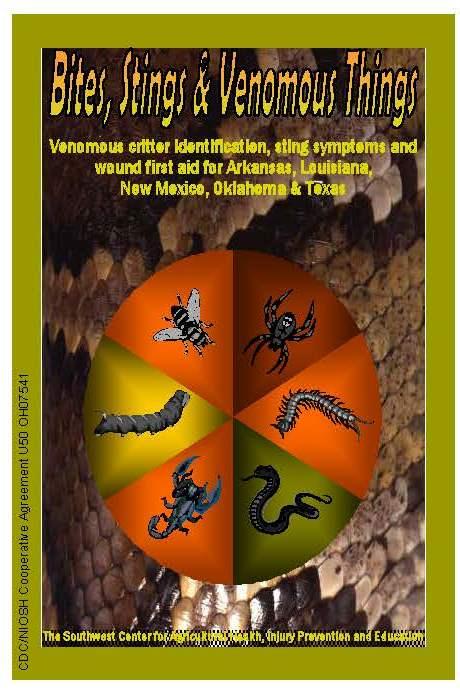Practically all of us have a story about an unpleasant encounter with a spider, bee, wasp, or snake. In 2011, the American Association of Poison Control Centers reported that the 57 poison control centers in the United States received over 66,000 calls for bites or venom poisoning (envenomations). The Bureau of Labor Statistics reported that bites and stings from insects, spiders, or bees caused 25 deaths in the same year. Agricultural, forestry, and fishing workers are at high risk for bites and stings because they typically spend more time outdoors or working near the habitats of venomous critters.
The best way to prevent a bite or sting is to be aware of the critters’ homes and follow some simple avoidance strategies. Because each venomous critter lives in a different environment, the recommendations vary.
Bees
- Stay clear of wild or commercial hives. Commercial hives usually look like white boxes and are clustered in fields near a pollen source.
- Be careful around hollow trees, rock crevices, or other sheltered locations.
- Avoid old or abandoned buildings, sheds, and vehicles.
- Old upholstery is an ideal bumblebee habitat. Be careful when moving pieces that have been outside.
- Do not use heavily scented soaps, perfumes, or colognes.
Scorpions
- Wear gloves when working outside or in barns and storage buildings.
- Pay attention when hand harvesting or gardening.
- Be cautious when moving rocks, firewood, lumber, and old boxes. Scorpions
frequently nest under bark or in other concealed locations. - Do not leave clothing or bedding on the floor, and always shake these items before use. Scorpions are common in houses and near new construction sites.
Snakes
- Wear long pants and boots when moving through high grass or rocky areas.
- Watch where you sit or place your hands and feet.
- Do not reach into spaces where you cannot see.
- Be very cautious walking through high grass or rocky areas.
- Pay attention as you move firewood, lumber, or other building materials.
- Step on fallen logs, not over them.
- Examine the ground around bodies of water.
- Be particularly aware at night when snakes are more active.
- If you see or hear a snake, back away. Snakes can strike about one-third of their body length.
Spiders
- Wear gloves when working outside or in barns and storage buildings.
- Never reach into areas where you cannot see.
- Exercise caution when moving rocks or wood.
- Be careful in attics, crawl spaces, basements, and closets.
- Look carefully into corners and crevices of buildings, porches, or boxes.
- Use a stick to sweep under the seat of outdoor toilets to dislodge venomous guests.

Even when you are armed with habitat and avoidance information, a bite or sting can occur. Your next best option is to identify what bit or stung you and perform wound first aid.
Free resources are available from the Southwest Center for Agricultural Health, Injury Prevention and Education to help. The Bites, Stings and Venomous Things tip booklet covers venomous critter identification, sting symptoms, and wound first aid for caterpillars, insects, millipedes, scorpions, snakes, and spiders. Colorful pictures, sting symptoms, and facts about typical behavior help you figure out what the culprit was and what to do next. Click HERE to access the resource in Spanish.
Resources
American Association of Poison Control Centers
Sources
2011 Annual Report of the American Association of Poison Control Centers’ National Poison Data System (NPDS): 29th Annual Report; https://aapcc.s3.amazonaws.com/pdfs/annual_reports/2011_NPDS_Annual_Report.pdf
Bureau of Labor Statistics: http://www.bls.gov/iif/oshwc/cfoi/cftb0267.pdf.
Bites, Stings and Venomous Things Tip Booklet (pdf): http://www.swagcenter.org/files/pdf/swagcenter_bsvt_english_rev_2015-jun….
